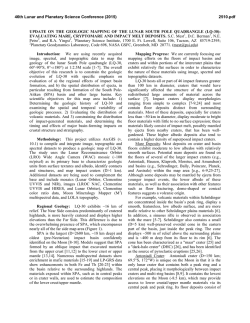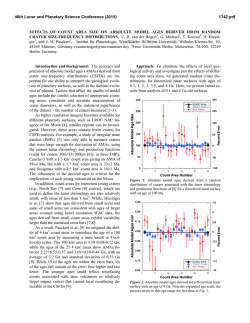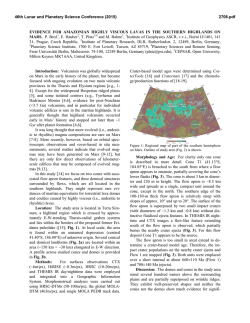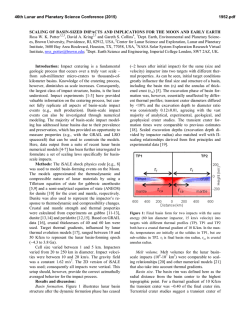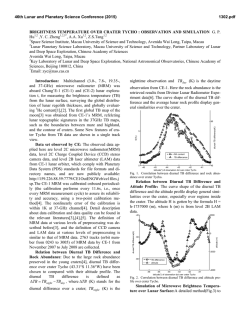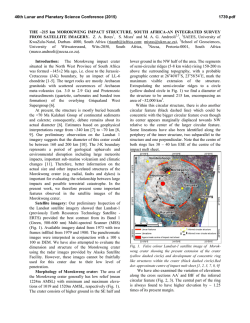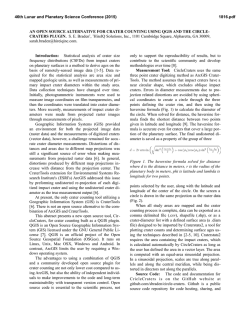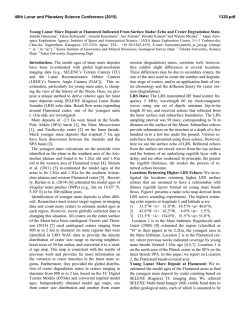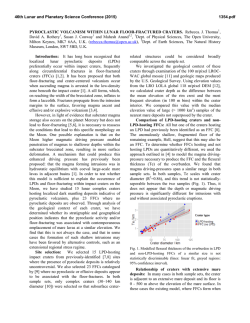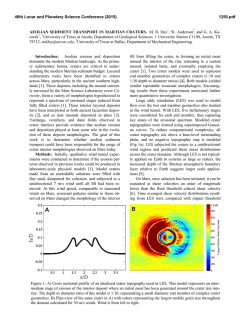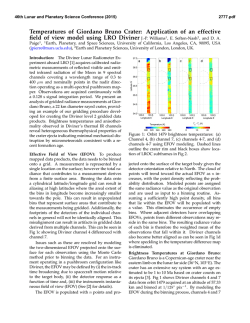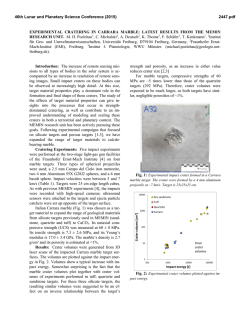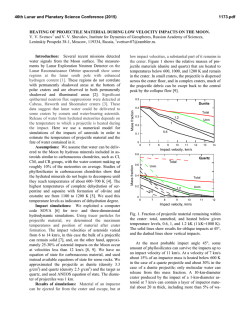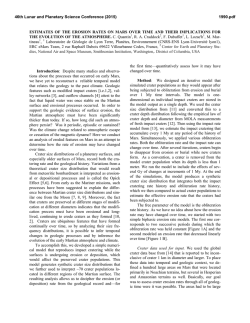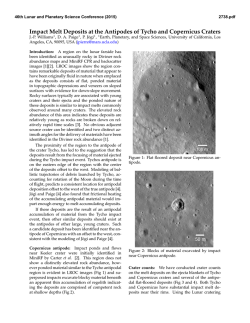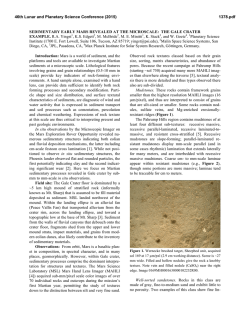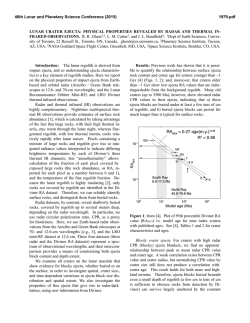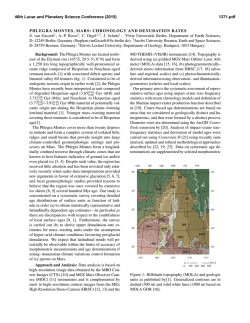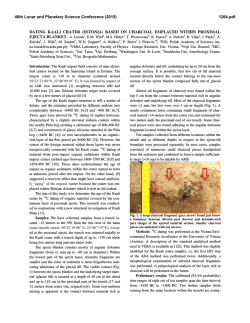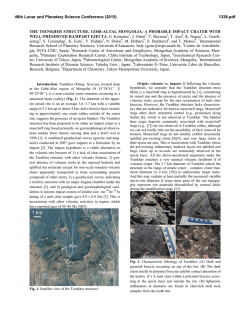
New Crater Size-Frequency Distribution Measurements for Cone
46th Lunar and Planetary Science Conference (2015) 1834.pdf NEW CRATER SIZE-FREQUENCY DISTRIBUTION MEASUREMENTS FOR CONE CRATER AT THE APOLLO 14 LANDING SITE. H. Hiesinger1, I. Simon1, C. H. van der Bogert1, M. S. Robinson2, J. B. Plescia3 1 Institut für Planetologie, Westfälische Wilhelms-Universität Münster,Wilhelm-Klemm-Str. 10, 48149 Münster, [email protected], 2Arizona State University, Tempe, AZ, USA, 3Johns Hopkins University, Applied Physics Laboratory, Laurel, MD, USA. Introduction: Accurate knowledge of the lunar cratering chronology is critical for deriving absolute model ages across the lunar surface and throughout the inner Solar System [e.g., 1]. Images from the Lunar Reconnaissance Orbiter (LRO) Narrow Angle Cameras (NAC) provide new opportunities to investigate crater size-frequency distributions (CSFDs) on individual geological units at key lunar impact craters. We report new CSFD measurements for the Copernican-aged Cone crater at the Apollo 14 landing site, which is an anchor point for the lunar cratering chronology. The lunar chronology is only constrained by a four data points over the last 1 Ga, i.e., Copernicus, Tycho, North Ray, and Cone craters, and there are no absolute age calibration points available between 1 and 3 Ga or beyond 3.9 Ga [2]. On the basis of these four young craters, a constant lunar impact rate for the last 3 Ga was postulated [e.g., 3,4]. Hence Copernicus, Tycho, North Ray, and Cone craters are crucial for the determination of an accurate lunar cratering chronology and our understanding of the impact rate in the inner Solar System (including Earth) over the last one billion years. Previously, we reported our results for Copernicus, Tycho, North Ray [1] and here we report new CSFD measurements for Cone crater. Cone Crater: Cone crater (340 m diameter) is located about 1100 m NE of the Apollo 14 landing site on a 90 m high ridge of the Fra Mauro Formation, and exhibits a sharp rim [e.g., 5,6,7]. On the basis of Apollo 14 seismic experiments, [8] proposed a thickness of the Fra Mauro Formation on the order of 20 to 70 m. Being 80 m deep [9], Cone crater is expected to have excavated mainly Fra Mauro material [6]. The ejecta of Cone crater is composed of breccias and a wide range of thermal metamorphism effects are seen in the ejecta material [9]. Figure 1 shows the four stations (Dg, C1, C2, C′) from which rock samples were returned to Earth [7]. Exposure ages derived from those samples were used to date the formation of Cone crater. Although there is a considerable range of exposure ages (~12 Ma [10] to ~661 Ma [11]), several studies of Cone crater samples indicate an age of ~25-26 Ma [e.g., 2,12,13]. Data and Method: We used LRO NAC image M114064206L to perform CSFD measurements. The image has a pixel scale of 0.5 m and an incidence angle of 58°. The image was calibrated and map- projected with ISIS 3 [14] and imported into ArcGIS. Within ArcGIS, we used CraterTools [15] to perform our measurements using techniques described in [1619]. The CSFDs were plotted with CraterStats [20], using the chronology function (CF) and production function (PF) of [4], which is valid in the diameter interval of 10 m to 100 km. However, we counted down to smaller crater diameters. For our crater counts, we mapped several homogeneous areas on the ejecta blanket of Cone crater and paid particular attention to avoid obvious secondary craters. Fig. 1: LRO NAC image of Cone crater with superposed count areas (yellow) and EVA2 track (green) with individual sampling stations (black boxes) Results: On the basis of our CSFD measurements we determined an absolute model age (AMA) for Cone crater of ~39 Ma, which is in the range of model ages derived by previous CSFD measurements that vary between ~24 Ma [21] and ~73 Ma [22] (Fig. 2). However, we found a wide spread of model ages ranging from ~16 to ~82 Ma, depending on the location of the count area on the ejecta blanket (Table 1). Like [22], 46th Lunar and Planetary Science Conference (2015) we find that the CSFD measurements on LROC images yield older AMAs than previous CSFDs [e.g., 21]. However, our results are closer to the older CSFDs than to those of [22] and are just within the error bars of [23]. Our derived N(1) = 3.26 x 10−5 km−2 is basically identical to the N(1) = 3.36 x 10−5 km−2 of [24]. We find that our summed crater counts (areas 1-9 combined) can be well fitted with the lunar production function. Thus, we do not find strong evidence for contamination with auto-secondary craters as suggested by [22] to explain CSFDs with slopes steeper than the PF in their data. Comparing our CSFD measurements to those of North Ray crater, for which we determined ages of 42-60 Ma, we find the ages of Cone and North Ray craters to be indistinguishable in our counts. Thus, we can confirm earlier findings by [22]. 1834.pdf rectly sampled by the astronauts. For these units we obtained ages that are 10 and 23 Ma older than the exposure ages [e.g., 12]. Fig. 3: Comparison of AMAs of individual count areas and their sum with the exposure age of Cone crater ([12]; red line) Fig. 2: Comparison of our CSFD-derived AMA (blue bar) with previous CSFD measurements [21-23; bottom] and exposure ages [2, 12; top] (red circles). Tab. 1: Sizes, N(D≥1 km), and absolute model ages of 9 count areas around Cone crater. See Fig. 1 for locations of the count areas. Last line shows the total of all CSFDs and is the age we adopt for our discussion. Comparing the CSFD results to exposure ages of the returned samples we find somewhat older ages (Fig. 3). However, at least two of our count areas, i.e., units 5 and 8, produce AMAs that are within the error bars of exposure age measurements [e.g., 12]. Six other units (2-4, 6-7, 9) fit within two standard deviations to the exposure ages [e.g., 12]. Units 4 and 9 were di- Conclusion: We find that CSFD measurements performed on the ejecta blanket of Cone crater yield AMAs that agree well with the exposure ages, considering the relatively small count areas and the hummocky nature of the ejecta blanket. However, the AMAs are generally older than the exposure ages, which may be due to the small count area sizes [25], a possibly higher recent impact rate [26], some unidentified secondary craters [22], poor calibration of the production function, or inaccurate exposure age dates. References: [1] Hiesinger et al. (2012) J. Geophys. Res. 117, 10.1029/2011JE003935. [2] Stöffler and Ryder (2001) Chronology and Evolution of Mars, 9-54. [3] Neukum (1983) Habil. thesis, U. of Munich. [4] Neukum et al. (2001) Space Sci. Rev. 96, 55-86. [5] Swann et al. (1971) Apollo 14 Prelim. Sci. Rep. SP-272, 39. [6] Carlson (1978) NASA STI/Recon Technical Report N, 78, 25022. [7] Swann (1977) Washington US Govt. Print. Off. [8] Kovach et al. (1971) Apollo 14 Prelim. Sci. Rep., 163. [9] Sutton et al. (1972) Proc. Lunar Planet. Sci. Conf. 3, 27-38. [10] Bhandari et al. (1972) Proc. Lunar Planet. Sci. Conf. 3, 2811-2829. [11] Crozaz et al. (1972) Proc. Lunar Planet. Sci. Conf. 3, 29172931. [12] Arvidson et al. (1975) Moon 13, 259–276. [13] Stadermann et al. (1991) Geochim. Cosmochim. Acta 55, 2339–2349. [14] Anderson et al. (2004) LPSC 35, #2039. [15] Kneissl et al. (2012) Planet. Space Sci. 59, 1243-1254. [16] Neukum et al. (2001) Space Sci. Rev. 96, 55-86. [17] Hiesinger et al. (2000) J. Geophys. Res. 105, 29239-29275. [18] Hartmann (1966) Icarus 5, 406-418. [19] Crater Analysis Working Group (1979) Icarus 37, 467-474. [20] Michael and Neukum, (2010) Earth Planet. Sci. Lett. 294, 223-229. [21] Moore et al. (1980) Moon and Planets 23, 231–252. [22] Plescia and Robinson (2011) LPSC 42, 1839. [23] Williams et al. (2014) Icarus 235, 23–36. [24] Robbins (2014) Earth Planet. Sci. Lett. 403,188–198. [25] van der Bogert et al. (2015) LPSC 46, #1742. [26] McEwen et al. (2015) LPSC 46.
© Copyright 2025
